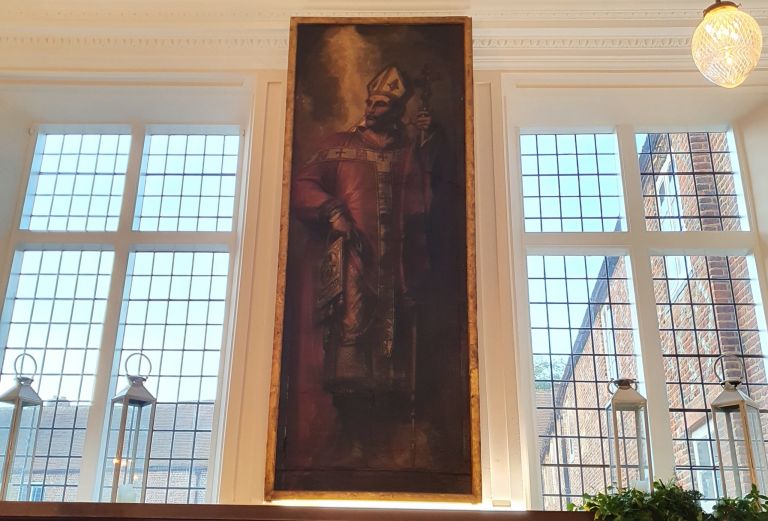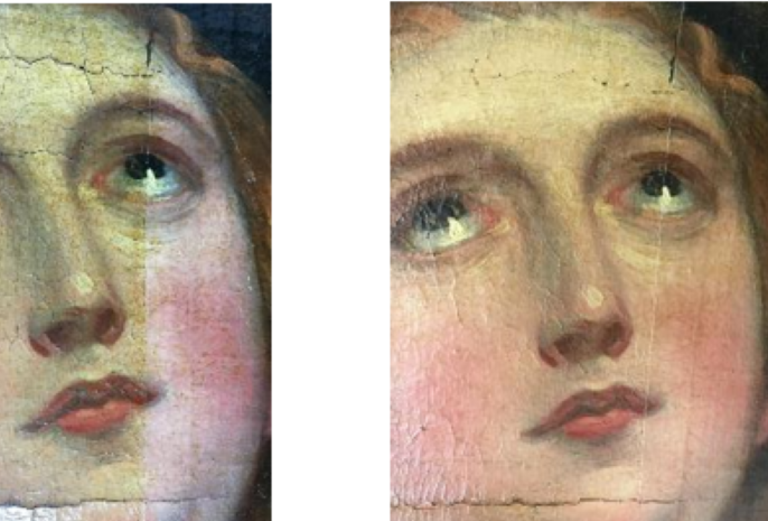
Roxane Burke, collections and conservation assistant
While the museum and historic rooms at Fulham Palace are temporarily closed to visitors during this third national lockdown, collections and conservation activities have been continuing. It is always a wonderful opportunity to share these events on our blog. Two of our largest pictures were taken off from their brass hanging chains in the great hall and removed for conservation. This delicate task was achieved by Fine Art Transport Services, who managed to effortlessly move and transport the paintings without a hitch! A time-lapsed video was recorded to capture this feat.
The paintings themselves are large-scale romanticised, religious depictions of two figures; St. Margaret, Queen of Scotland (c.1046-1093) and Thomas à Becket (c.1118-1170), a former Archbishop of Canterbury who was brutally murdered by knights of King Henry II’s court. They were created by Benjamin West (1738-1820), an American-born painter, for art collector William Beckford (1760-1844) who commissioned several designs for stained-glass windows for his home of Fonthill Abbey in Wiltshire.

I write “home” but this is an understatement, the term does not well describe the over-ambitious and grandiose Gothic Revival style house which was also referred to as Beckford’s Folly! At present, only the north wing remains since the original tower’s soaring height, combined with problematic construction, meant the building was prone to collapse and was demolished eventually in 1845.
These two figures were painted on paper and laid on canvas as full-scale templates for future work in a different type of media. These objects are known as ‘cartoons’. West’s style was heavily influenced by Raphael’s cartoons, for tapestries meant to be hung in the Sistine Chapel in Rome. With George III’s patronage, West would have been invited, alongside other prominent contemporary artists, to the saloon at Buckingham House where the cartoons were displayed (now on loan at the V&A Museum). His legacy stands as a leading figure in the development of historical painting in Britain.

It is quite remarkable that these paintings were able to survive until today since it is unknown if they were meant to be retained or disposed of after they were copied. Nevertheless, from a preservation perspective, paintings on paper are more challenging than those on canvas. The type of media is more vulnerable and prone to damage from its surrounding environment, particularly from changes in humidity levels and temperature. This leads to warping and cracking, affecting overlying layers (such as primer and paint) resulting in flaking and loss of material. Age and composition are contributing factors leading to deterioration. The portraits have visible signs of instability around the edges of the paper sheets where sections have lifted from the support and deformed.

The aim of the conservation treatment is in-depth examination of the paintings, with subsequent stabilisation of unstable areas. This work will be completed by intern Luz Vanasco supervised by fine art conservator Jim Dimond, as part of her six-month placement. The conservation placement has been generously provided through a grant from the Pilgrim Trust. We hope our currently fundraising efforts will allow our second cartoon by West, which shows Thomas à Becket, to be treated too shortly.
Whenever we are able to reopen, be sure to visit these wonderful, newly-conserved paintings in the great hall!